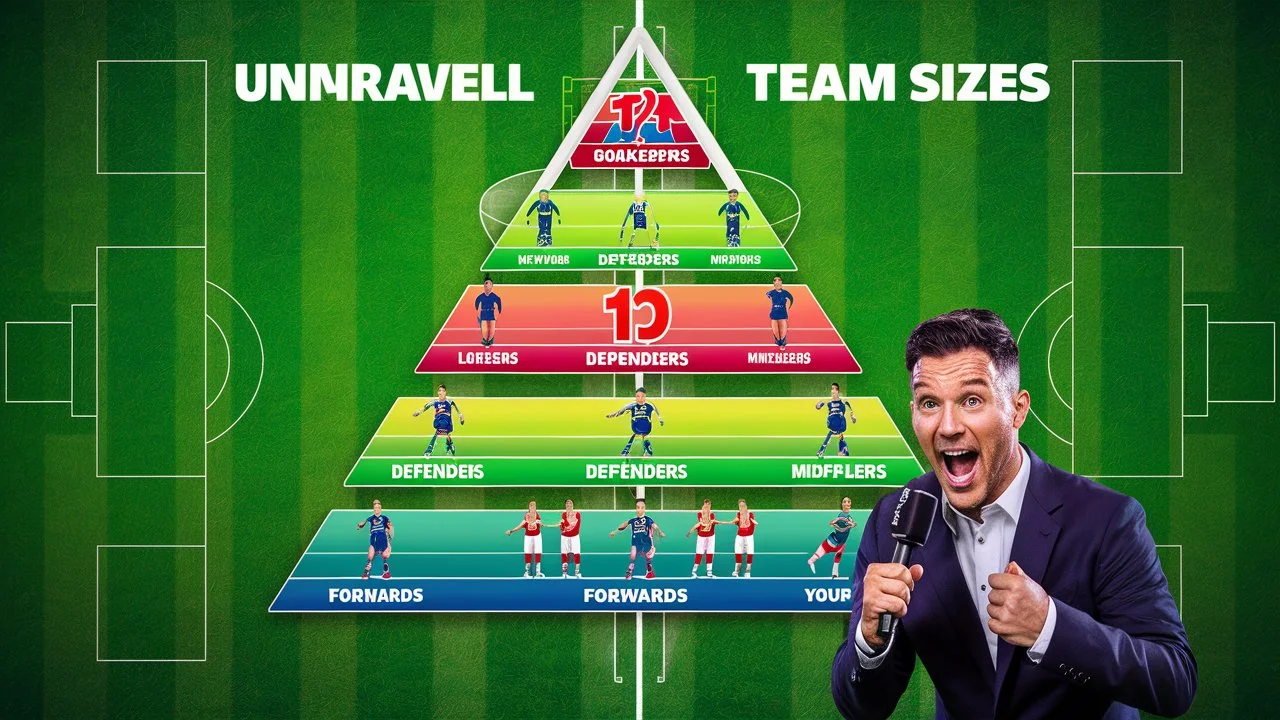Football is a sport loved by millions worldwide, captivating fans with its exciting gameplay and strategic complexity. One of the key aspects that shape the dynamics of the game is the number of football players on the field. Understanding the standard football team sizes and the roles of each player is essential for both new fans and seasoned enthusiasts. This article aims to unravel the mystery behind team sizes in football, covering everything from the historical evolution of football team sizes to the specific roles and positions in different football formats.
Historical Background: Discover the origins of football and how team sizes have evolved over time.
Standard Team Sizes: Learn about the standard number of players on the field in various football formats, including soccer and American football.
Player Positions: Explore the detailed roles and responsibilities of players in different positions.
By delving into these topics, you’ll gain a comprehensive understanding of why soccer team positions and American football positions are structured the way they are. This knowledge will enhance your appreciation of the game’s strategies and the critical decisions made by coaches regarding team sizes. Whether you’re a casual fan or a budding football analyst, this article will provide valuable insights into the fascinating world of football team sizes and football player roles. So, let’s kick off our exploration and discover what makes football one of the most strategic and engaging sports in the world!
Historical Background of Football Team Sizes
Football, in its various forms, has a rich history that dates back centuries. Understanding how football team sizes have evolved helps us appreciate the game’s current structure and rules.
Early Beginnings
The origins of football can be traced back to ancient civilizations, where various forms of the game were played.
In medieval England, large groups would participate in chaotic versions of football, with no set number of players.
These early versions laid the groundwork for the organized sport we know today.
Evolution Over the Centuries
The 19th century saw significant changes in football, particularly in England, where the sport began to be codified.
Soccer, also known as association football, standardized the number of players on the field to 11 per team. This change was formalized in 1863 with the establishment of the Football Association in England.
Meanwhile, American football, which evolved from rugby, underwent its own transformations. The number of players was initially fluid but was later standardized to 11 players per team by the early 20th century.
Key Changes in Rules Affecting Team Sizes
The introduction of rules and formal competitions necessitated consistent team sizes. For example, the Laws of the Game, established by the International Football Association Board (IFAB), solidified the 11-player format for soccer team positions.
In American football, the forward pass and other rule changes influenced the structure and strategy of the game, reinforcing the need for a specific number of players on the field.
Impact of Historical Changes
These historical developments in team sizes have had a profound impact on the way the game is played today.
The standardization of team sizes allowed for more strategic and organized gameplay, making football one of the most popular sports globally.
Understanding the historical context of football team sizes enriches our appreciation of the sport’s evolution and the intricacies of its modern rules.
In summary, the evolution of football team sizes from ancient times to the present day highlights the importance of structured gameplay and strategic organization. The journey from chaotic early games to the standardized formats of soccer and American football reflects the sport’s development and the enduring appeal of football around the world.
Standard Football Team Sizes
Understanding the standard football team sizes is crucial for grasping the dynamics of the game. Different formats of football have varying numbers of players, each contributing to the unique style and strategy of the sport.
Soccer: The Global Game
Number of Players: In soccer, each team fields 11 players, including one goalkeeper.
Player Positions: The standard positions include the goalkeeper, defenders, midfielders, and forwards.
Goalkeeper: The sole player allowed to use their hands, primarily responsible for preventing the opposition from scoring.
Defenders: Typically four players, including center backs and fullbacks, tasked with stopping attacks and protecting the goalkeeper.
Midfielders: Usually four to five players, including defensive, central, and attacking midfielders, who link defense and attack.
Forwards: Generally two to three players, including strikers and wingers, whose main role is to score goals.
American Football: The Tactical Showdown
Number of Players: American football teams also have 11 players on the field.
Player Positions: The team is divided into offense, defense, and special teams.
Offense:
Quarterback: The leader of the offense, responsible for passing or handing off the ball.
Running Backs: Players who run with the ball after handoffs.
Wide Receivers: Players who catch passes from the quarterback.
Tight Ends: Versatile players who block and catch passes.
Offensive Line: Includes the center, guards, and tackles who protect the quarterback and block for the running backs.
Defense:
Defensive Line: Players who rush the passer and stop running plays.
Linebackers: Versatile defenders who tackle runners, cover receivers, and blitz the quarterback.
Cornerbacks and Safeties: Defensive backs who cover receivers and defend against passing plays.
Special Teams: Includes players for kicking, punting, and returning kicks.
Rugby: A Different Dynamic
Number of Players: Rugby union teams consist of 15 players, while rugby league teams have 13.
Player Positions: Positions include forwards and backs, each with specific roles.
Forwards: Focus on physical contests and gaining possession of the ball.
Backs: Known for speed and agility, tasked with advancing the ball and scoring.
Canadian Football: Similar Yet Distinct
Number of Players: Canadian football teams have 12 players on the field.
Player Positions: Similar to American football, but with an extra player usually in the backfield or as an additional wide receiver.
Unique Rules: The larger field and additional player contribute to a more open and faster-paced game.
Australian Rules Football: Unique and Fast-Paced
Number of Players: Teams consist of 18 players on the field.
Player Positions: Includes forwards, midfielders, and defenders, each with specific roles in a fast-paced, high-scoring game.
Summary
Understanding the standard football team sizes across different formats highlights the diversity and strategic depth of the sport. From soccer’s 11-player teams to rugby’s 15-player squads, each format brings its unique flavor and complexity to the world of football. This knowledge not only enriches your appreciation of the game but also enhances your ability to engage in informed discussions about football player roles and strategies.
Soccer: Players and Positions
Soccer, known as the world’s most popular sport, captivates millions with its simplicity and strategic depth. Understanding the number of soccer players on the field and their roles is key to appreciating the game fully.
Overview of the 11-Player Format
Standard Team Size: Each soccer team fields 11 players, including one goalkeeper and ten outfield players.
Field Layout: The field is divided into three main areas: defense, midfield, and attack. Each area is manned by players with specific roles and responsibilities.
Detailed Description of Each Position
Goalkeeper (1 player)
Role: The goalkeeper is the last line of defense, responsible for stopping shots and preventing goals. They are the only player allowed to use their hands within the penalty area.
Skills: Excellent reflexes, shot-stopping ability, and command of the penalty area.
Defenders (typically 4 players)
Center Backs (2 players):
Role: Central defenders protect the area directly in front of the goalkeeper, blocking shots and making tackles.
Skills: Strong tackling, aerial ability, and positional awareness.
Fullbacks (2 players):
Role: Fullbacks play on the sides of the defense, tasked with preventing crosses and supporting offensive plays.
Skills: Speed, crossing ability, and defensive positioning.
Midfielders (typically 4-5 players)
Defensive Midfielders (1-2 players):
Role: Shield the defense by breaking up opposition attacks and distributing the ball to more offensive players.
Skills: Tackling, passing, and positional discipline.
Central Midfielders (2-3 players):
Role: The heart of the team, central midfielders link defense and attack, control possession, and dictate the pace of the game.
Skills: Passing, vision, and stamina.
Attacking Midfielders (1 player):
Role: Positioned closer to the forwards, they create scoring opportunities and often take shots on goal.
Skills: Dribbling, creativity, and shooting.
Forwards (typically 2-3 players)
Wingers (2 players):
Role: Wingers play on the flanks, delivering crosses and stretching the opposition’s defense.
Skills: Speed, dribbling, and crossing.
Strikers (1-2 players):
Role: The main goal scorers, strikers are positioned closest to the opponent’s goal and are responsible for finishing attacking plays.
Skills: Finishing, positioning, and heading.
Common Formations and Their Impact on Player Positions
4-4-2 Formation: This traditional formation includes four defenders, four midfielders, and two forwards. It offers a balanced approach between defense and attack.
4-3-3 Formation: With four defenders, three midfielders, and three forwards, this formation emphasizes offensive play and width.
3-5-2 Formation: Featuring three defenders, five midfielders, and two forwards, it focuses on controlling the midfield and providing defensive solidity.
Roles and Responsibilities
Goalkeeper: Prevents goals, organizes the defense, and initiates attacks with throws or kicks.
Defenders: Protect the goal, block shots, make tackles, and start offensive plays from the back.
Midfielders: Link defense and attack, maintain possession, and create scoring opportunities.
Forwards: Score goals, apply pressure on the opposition’s defense, and create space for teammates.
Summary
Understanding the soccer team positions and the roles of each player on the field is crucial for appreciating the strategic depth and excitement of the game. From the goalkeeper’s critical saves to the striker’s thrilling goals, every player contributes to the team’s success in unique ways. Whether you’re a casual fan or a budding analyst, knowing these details enriches your enjoyment and understanding of soccer.
American Football: Players and Positions
American football is a complex and strategic game, with each player on the field having a specific role that contributes to the team’s success. Understanding the number of players on the field and their positions helps in grasping the intricacies of the game.
Overview of the 11-Player Format
Standard Team Size: In American football, each team has 11 players on the field at any given time.
Team Divisions: The team is divided into three units: offense, defense, and special teams. Each unit has specialized roles and responsibilities.
Detailed Description of Offensive Positions
Quarterback (1 player)
Role: The quarterback (QB) is the leader of the offense, responsible for calling plays, throwing passes, and handing off the ball.
Skills: Strong arm, accuracy, decision-making, and leadership.
Running Backs (2 players)
Halfback:
Role: Primarily responsible for carrying the ball on running plays and catching passes out of the backfield.
Skills: Speed, agility, and vision.
Fullback:
Role: Acts as a lead blocker for the halfback and occasionally carries the ball.
Skills: Strength, blocking ability, and toughness.
Wide Receivers (2-3 players)
Role: Wide receivers (WR) run routes to catch passes from the quarterback.
Skills: Speed, route running, catching, and agility.
Tight End (1 player)
Role: A versatile player who can block like an offensive lineman and catch passes like a receiver.
Skills: Strength, blocking, and catching.
Offensive Line (5 players)
Center:
Role: Snaps the ball to the quarterback and blocks defensive players.
Skills: Strength, snapping accuracy, and blocking.
Guards (2 players):
Role: Block defensive players and protect the quarterback.
Skills: Strength and blocking.
Tackles (2 players):
Role: Protect the quarterback from edge rushers and block for running plays.
Skills: Strength and blocking.
Detailed Description of Defensive Positions
Defensive Line (3-4 players)
Role: Rush the passer and stop the run. Includes defensive ends (DE) and defensive tackles (DT).
Skills: Strength, tackling, and pass-rushing ability.
Linebackers (3-4 players)
Role: Versatile defenders who can stop the run, cover receivers, and blitz the quarterback.
Skills: Tackling, coverage, and versatility.
Defensive Backs (4 players)
Cornerbacks (2 players):
Role: Cover wide receivers and defend against passing plays.
Skills: Speed, coverage skills, and ball-handling.
Safeties (2 players):
Role: Provide deep coverage and support against the run.
Skills: Speed, tackling, and coverage.
Detailed Description of Special Teams Positions
Kicker (1 player)
Role: Kicks field goals and extra points.
Skills: Accuracy and leg strength.
Punter (1 player)
Role: Kicks the ball to the other team on fourth down.
Skills: Leg strength and placement accuracy.
Return Specialists (2 players)
Role: Return kickoffs and punts.
Skills: Speed, agility, and vision.
Long Snapper (1 player)
Role: Snaps the ball on punts and field goals.
Skills: Snapping accuracy and blocking.
Common Formations and Their Impact on Player Positions
Offensive Formations:
I-Formation: Utilizes a fullback and halfback behind the quarterback for strong running plays.
Shotgun Formation: The quarterback stands further back to allow for better passing and quick decision-making.
Defensive Formations:
4-3 Defense: Four defensive linemen and three linebackers provide a balanced defense against both run and pass plays.
3-4 Defense: Three defensive linemen and four linebackers offer versatility in blitzing and coverage.
Roles and Responsibilities
Quarterback: Directs the offense, makes throws, and reads defenses.
Running Backs: Carry the ball, catch passes, and block.
Wide Receivers: Run routes, catch passes, and block for other players.
Tight End: Blocks and catches passes.
Offensive Line: Protects the quarterback and blocks for running plays.
Defensive Line: Rushes the passer and stops the run.
Linebackers: Defend against the run, cover receivers, and blitz.
Defensive Backs: Cover receivers and defend against passes.
Special Teams: Handle kicking, punting, and returns.
Summary
Understanding the American football positions and the roles of each player is essential for appreciating the game’s complexity and strategic depth. From the quarterback’s crucial decisions to the defensive line’s pressure, every player contributes to the team’s success. This knowledge enhances your enjoyment and understanding of American football, whether you’re watching a game or analyzing plays.
Basketball: Players and Positions
Basketball is a fast-paced and dynamic sport played by millions worldwide. Understanding the number of basketball players on the court and their roles helps in appreciating the game’s speed and strategic depth.
Overview of the 5-Player Format
Standard Team Size: Each basketball team has 5 players on the court at any given time.
Court Layout: The court is divided into two main areas: offense and defense. Players switch between these roles throughout the game.
Detailed Description of Each Position
Point Guard (1 player)
Role: The point guard (PG) is the team’s primary ball-handler and playmaker, responsible for directing the offense and making crucial decisions.
Skills: Dribbling, passing, vision, and leadership.
Shooting Guard (1 player)
Role: The shooting guard (SG) is typically the team’s best shooter, focusing on scoring from long-range shots and driving to the basket.
Skills: Shooting, scoring, and ball-handling.
Small Forward (1 player)
Role: The small forward (SF) is versatile, able to score from both inside and outside the arc, and often tasked with defending the opposing team’s best scorer.
Skills: Versatility, scoring, and defense.
Power Forward (1 player)
Role: The power forward (PF) plays near the basket, focusing on rebounding, post-play, and mid-range shooting.
Skills: Strength, rebounding, and scoring.
Center (1 player)
Role: The center (C) is the tallest player, responsible for protecting the rim, rebounding, and scoring in the paint.
Skills: Height, strength, and shot-blocking.
Common Formations and Their Impact on Player Positions
Traditional Lineup: Features distinct roles for each position, focusing on specific tasks like playmaking, shooting, and rebounding.
Small-Ball Lineup: Uses smaller, quicker players to emphasize speed, shooting, and spacing.
Tall Lineup: Features bigger players to dominate rebounding and interior defense.
Offensive Roles and Responsibilities
Point Guard: Directs the offense, creates scoring opportunities for teammates, and controls the game’s tempo.
Shooting Guard: Scores from long range and drives to the basket, often playing off the ball.
Small Forward: Versatile scorer and defender, capable of playing both inside and outside.
Power Forward: Scores in the paint and mid-range, provides physical presence for rebounding and defense.
Center: Protects the rim, rebounds, and scores in the post.
Defensive Roles and Responsibilities
Point Guard: Defends the opposing point guard, often applying full-court pressure.
Shooting Guard: Defends against perimeter scorers, provides help defense.
Small Forward: Guards versatile scorers, contributes to team defense.
Power Forward: Protects the paint, defends against bigger forwards.
Center: Anchors the defense, blocks shots, and secures rebounds.
Key Strategies and Their Impact on Player Positions
Pick and Roll: Involves a player setting a screen to free up the ball-handler for a shot or drive, requiring coordination between guards and big men.
Isolation Plays: Focuses on creating one-on-one situations for a team’s best scorer, often used by shooting guards and small forwards.
Fast Break: Relies on speed and quick passing to score before the defense can set up, highlighting the roles of point guards and wings.
Summary
Understanding the basketball positions and the roles of each player on the court is essential for appreciating the game’s pace and strategic complexity. From the point guard’s playmaking to the center’s rim protection, every player contributes to the team’s success in unique ways. This knowledge enhances your enjoyment and understanding of basketball, whether you’re watching a game or analyzing plays.
Ice Hockey: Players and Positions
Ice hockey is a thrilling and fast-paced sport, known for its intense physicality and strategic depth. Knowing the number of players on the ice and their positions is crucial to understanding the game’s complexity and excitement.
Overview of the 6-Player Format
Standard Team Size: Each ice hockey team has 6 players on the ice at any given time.
Team Divisions: The team is divided into forwards, defensemen, and a goaltender, each with specific roles and responsibilities.
Detailed Description of Each Position
Goaltender (1 player)
Role: The goaltender (or goalie) is the last line of defense, tasked with stopping the puck and preventing goals.
Skills: Reflexes, positioning, and agility.
Defensemen (2 players)
Right Defenseman:
Role: Defends the right side of the ice, prevents opponents from scoring, and helps clear the puck from the defensive zone.
Skills: Defensive positioning, shot-blocking, and puck movement.
Left Defenseman:
Role: Defends the left side of the ice, works with the right defenseman to protect the net and support the offense.
Skills: Defensive skills, physicality, and puck handling.
Forwards (3 players)
Center (1 player):
Role: The center plays both offense and defense, often involved in face-offs, and distributes the puck to wingers.
Skills: Playmaking, skating, and two-way play.
Right Wing (1 player):
Role: Positioned on the right side, the right wing is responsible for scoring goals and assisting the center.
Skills: Scoring, speed, and puck control.
Left Wing (1 player):
Role: Positioned on the left side, the left wing supports the center and defends when necessary.
Skills: Scoring, agility, and defensive play.
Common Formations and Their Impact on Player Positions
1-2-2 Formation: One defenseman stays back, two are in the neutral zone, and two forwards are deep. This formation focuses on a balanced approach between offense and defense.
2-1-2 Formation: Two defensemen play deep, one in the middle, and two forwards on each side. This setup aims to control the puck and apply pressure in the offensive zone.
Defensive Zone Coverage: Involves players positioning themselves to block shots and clear the puck from the defensive area.
Offensive Roles and Responsibilities
Goaltender: Stops shots and communicates with defensemen to manage the crease.
Defensemen: Protect the goaltender, block shots, and move the puck up the ice.
Center: Leads offensive plays, supports wingers, and participates in face-offs.
Right Wing and Left Wing: Score goals, assist in offensive plays, and help in defensive duties.
Defensive Roles and Responsibilities
Goaltender: Guards the net, positions themselves to block shots, and controls rebounds.
Defensemen: Block shots, clear the puck, and cover opposing forwards.
Center: Supports defensemen, covers the opposing center, and helps in defensive zone plays.
Right Wing and Left Wing: Backcheck to help defensemen, cover opposing wingers, and clear the puck from the defensive zone.
Key Strategies and Their Impact on Player Positions
Power Play: Utilizes an extra player due to an opponent’s penalty, focusing on creating scoring opportunities with improved puck movement.
Penalty Kill: Defending with one less player, requiring strong positioning and aggressive puck clearing to prevent goals.
Forechecking: Applying pressure on the opposing team in their defensive zone to regain puck possession.
Summary
Understanding the ice hockey positions and the roles of each player on the ice is essential for appreciating the game’s speed and strategic depth. From the goaltender’s crucial saves to the defensemen’s protective duties, each player contributes uniquely to the team’s performance. This knowledge enhances your enjoyment and understanding of ice hockey, whether you’re watching a game or analyzing plays.
Volleyball: Players and Positions
Volleyball is an exciting and fast-paced sport played both indoors and on the beach. Understanding the number of volleyball players on the court and their specific roles is essential to appreciating the game’s dynamics and strategies.
Overview of the 6-Player Format
Standard Team Size: In indoor volleyball, each team has 6 players on the court at any given time.
Court Layout: The court is divided into front row (attack) and back row (defense), with players rotating through these positions.
Detailed Description of Each Position
Outside Hitter (Left Side Hitter) (1 player)
Role: The primary attacker for the team, responsible for scoring points and receiving serves.
Skills: Powerful hitting, passing, and defense.
Right Side Hitter (1 player)
Role: Attacks from the right side of the court, provides blocking on the opponent’s left side, and supports in defense.
Skills: Blocking, hitting, and strategic positioning.
Middle Blocker (1 player)
Role: Focuses on blocking the opponent’s attacks and quick middle attacks for the team.
Skills: Blocking, quick reflexes, and timing.
Setter (1 player)
Role: The playmaker who sets up the ball for attackers, responsible for distributing the ball to the team’s hitters.
Skills: Accurate setting, vision, and decision-making.
Libero (1 player)
Role: Specializes in defensive plays, especially receiving serves and digging balls. The libero wears a different color jersey and cannot attack above the net.
Skills: Defensive skills, agility, and quick reflexes.
Defensive Specialist (1 player)
Role: Substitutes in for a front-row player to strengthen defense, often used for serve receive and digging.
Skills: Defensive techniques, passing, and communication.
Common Formations and Their Impact on Player Positions
Rotation Formation: Players rotate positions in a clockwise manner after winning the serve, ensuring each player serves and plays both front and back row.
4-2 Formation: Two setters and four attackers. Provides strong setting and balanced offense.
5-1 Formation: One setter and five attackers. Offers a consistent offensive strategy with one setter setting all the plays.
Offensive Roles and Responsibilities
Outside Hitter: Primary attacker, responsible for powerful spikes and effective coverage of tips and off-speed shots.
Right Side Hitter: Attacks from the right side, supports in blocking, and provides additional offensive options.
Middle Blocker: Performs quick attacks and blocks, often crucial in countering the opponent’s offense.
Setter: Delivers accurate sets to attackers, manages tempo and flow of play.
Defensive Roles and Responsibilities
Libero: Receives serves, digs attacks, and plays a key role in keeping the ball in play.
Defensive Specialist: Focuses on serve receive and defense, often brought in to improve back-row play.
Key Strategies and Their Impact on Player Positions
Serve Receive: Involves coordinated efforts from the setter, libero, and outside hitter to handle the opponent’s serve effectively.
Blocking: Middle blockers and right side hitters work to prevent the opponent’s spikes, requiring timing and positioning.
Offensive Plays: Includes quick sets, high balls, and combination plays to confuse the opposing defense and create scoring opportunities.
Summary
Understanding the volleyball positions and the roles of each player on the court is essential for appreciating the game’s pace and tactical depth. From the setter’s strategic playmaking to the libero’s defensive skills, every player has a unique contribution to the team’s success. This knowledge enhances your enjoyment and understanding of volleyball, whether you’re watching a game or analyzing plays.
Tennis: Players and Positions
Tennis is a thrilling sport that requires skill, strategy, and physical endurance. Whether played singles or doubles, understanding the number of players and their roles can enhance your appreciation of the game.
Overview of the 1-Player and 2-Player Formats
Singles Format: Each match features 2 players, one on each side of the court.
Doubles Format: Each match features 4 players, with 2 players on each team.
Detailed Description of Each Position
Singles Player (1 player)
Role: Plays against one opponent, covering the entire court and managing both offensive and defensive plays.
Skills: Strong serve, precise shot placement, and stamina.
Doubles Player (2 players per team)
Role: Each team has two players who alternate shots and cover different areas of the court.
Skills: Communication, teamwork, and strategic positioning.
Singles Player: Key Responsibilities and Strategies
Serving
Role: Initiates play by serving the ball into the opponent’s service box.
Skills: Powerful and accurate serve, consistency.
Strategies: Use different types of serves (e.g., flat, topspin) to gain an advantage.
Baseline Play
Role: Involves rallying from the baseline with groundstrokes.
Skills: Powerful forehands and backhands, footwork.
Strategies: Maintain consistent depth, vary shots to disrupt opponent’s rhythm.
Net Play
Role: Involves approaching the net to hit volleys and put away points.
Skills: Quick reflexes, precise volleying.
Strategies: Approach the net at the right time, use drop shots to bring opponent forward.
Defensive Play
Role: Involves retrieving difficult shots and staying in the point.
Skills: Speed, anticipation, and shot placement.
Strategies: Use defensive lobs and angle shots to regain control.
Doubles Player: Key Responsibilities and Strategies
Serving
Role: One player serves while their partner positions themselves for the return.
Skills: Accurate serving, strategic positioning.
Strategies: Serve to the weaker opponent, use effective serve-and-volley tactics.
Positioning
Role: Players need to position themselves effectively to cover the court and support each other.
Skills: Communication, awareness of partner’s position.
Strategies: Coordinate movements, cover open spaces, and switch roles as needed.
Team Play
Role: Involves working together to execute strategies and cover the court.
Skills: Teamwork, signaling, and understanding each other’s strengths.
Strategies: Use formations (e.g., one at net, one at baseline) and strategic plays.
Net Play
Role: Involves both players being involved in net play to intercept and volley shots.
Skills: Quick reflexes, coordination.
Strategies: Use effective poaching, covering angles, and positioning to control the net.
Common Formations and Their Impact on Player Positions
Singles Formation
Baseline Play: Both players primarily stay at the baseline, with occasional net approaches.
Net Play: Occasional, depending on strategy and opponent’s play.
Doubles Formation
One-Up, One-Back: One player at the net and one at the baseline, providing coverage and flexibility.
Both-Up: Both players at the net, focusing on aggressive net play and volleying.
Key Strategies and Their Impact on Player Positions
Serve and Volley: Involves serving and immediately rushing to the net, effective in both singles and doubles.
Baseline Rallying: Focuses on long rallies from the baseline, requiring strong groundstrokes and footwork.
Poaching: Involves intercepting the opponent’s shots at the net, particularly in doubles.
Summary
Understanding the tennis positions and the roles of each player is crucial for appreciating the game’s strategy and execution. From the singles player’s comprehensive court coverage to the doubles team’s strategic coordination, every aspect of tennis requires skill and teamwork. This knowledge enhances your enjoyment and understanding of tennis, whether you’re watching a match or playing the game.
Rugby: Players and Positions
Rugby is a high-intensity sport known for its physicality and strategic depth. Understanding the number of rugby players on the field and their specific roles is essential for appreciating the game’s complexity and excitement.
Overview of the 15-Player Format
Standard Team Size: In rugby union, each team has 15 players on the field at any given time.
Team Divisions: The team is divided into forwards and backs, each with distinct responsibilities and roles.
Detailed Description of Each Position
Forwards (8 players)
Props (Loosehead and Tighthead) (2 players)
Role: Provide stability in scrums and support in open play.
Skills: Strength, scrummaging technique, and support in rucks and mauls.
Hooker (1 player)
Role: Throws the ball in at lineouts and hooks the ball in scrums.
Skills: Accurate throwing, scrummaging, and tackling.
Locks (2 players)
Role: Provide power in scrums and lift players during lineouts.
Skills: Jumping, physicality, and lineout skills.
Flankers (Open-side and Blind-side) (2 players)
Role: Support both the forwards and backs, focusing on tackling and winning turnovers.
Skills: Speed, tackling, and breakdown skills.
Number 8 (1 player)
Role: Controls the ball at the base of the scrum and links between forwards and backs.
Skills: Ball handling, strength, and decision-making.
Backs (7 players)
Scrum-half (1 player)
Role: Links forwards and backs, often the first to receive the ball from the scrum or lineout.
Skills: Passing, decision-making, and quick reactions.
Fly-half (1 player)
Role: Directs the attack, often kicking for goal and setting up plays.
Skills: Tactical kicking, passing, and game management.
Centers (Inside and Outside) (2 players)
Role: Break through opposition defenses and create attacking opportunities.
Skills: Strong running, tackling, and passing.
Wingers (2 players)
Role: Finish scoring opportunities and cover the flanks of the field.
Skills: Speed, finishing ability, and defensive coverage.
Fullback (1 player)
Role: Covers the back field, catches high balls, and supports the attack.
Skills: High-ball catching, counter-attacking, and positional play.
Common Formations and Their Impact on Player Positions
Scrum Formation
Role: A formation used to restart play after minor infringements, with forwards binding together to contest possession.
Impact: Requires props, hooker, and locks to provide stability and power.
Lineout Formation
Role: A method of restarting play when the ball goes out of bounds, involving lifting players to catch the ball.
Impact: Requires locks and the hooker to execute effective lineouts.
Ruck and Maul
Role: Forms of contesting possession after a tackle or a ball held up by players.
Impact: Flankers and number 8 are crucial in competing for possession.
Offensive Roles and Responsibilities
Forwards:
Role: Engage in scrums, lineouts, and rucks to secure possession and provide support.
Skills: Physical strength, scrummaging, and breakdown play.
Backs:
Role: Use tactical plays and passing to break through defenses and score.
Skills: Speed, skillful handling, and tactical awareness.
Defensive Roles and Responsibilities
Forwards:
Role: Defend against the opposition’s attack, particularly in scrums and mauls.
Skills: Tackling, rucking, and positional play.
Backs:
Role: Cover the field, tackle opposition players, and prevent scoring opportunities.
Skills: Speed, tackling, and positional awareness.
Key Strategies and Their Impact on Player Positions
Forward Dominance: Focuses on controlling scrums and lineouts to gain possession and dictate play.
Backline Attack: Involves creative passing and running to break through defenses and score.
Kick and Chase: Uses tactical kicking to gain territory and apply pressure on the opposing team.
Summary
Understanding the rugby positions and the roles of each player on the field is crucial for appreciating the game’s strategic and physical demands. From the forwards’ powerful scrums to the backs’ dynamic attacking play, each player has a vital role in the team’s success. This knowledge enhances your enjoyment and understanding of rugby, whether you’re watching a match or analyzing the strategies involved.
Field Hockey: Players and Positions
Field hockey is a fast-paced sport known for its skillful play and strategic depth. Understanding the number of players on the field and their specific roles is essential for appreciating the game’s complexity and excitement.
Overview of the 11-Player Format
Standard Team Size: Each field hockey team has 11 players on the field at any given time.
Team Divisions: The team is divided into forwards, midfielders, and defenders, with a goalkeeper.
Detailed Description of Each Position
Goalkeeper (1 player)
Role: The last line of defense, responsible for stopping the ball from entering the goal.
Skills: Quick reflexes, agility, and strong shot-blocking abilities.
Defenders (4 players)
Fullbacks (2 players)
Role: Positioned near the defensive circle, their primary role is to block attacks and clear the ball.
Skills: Tackling, marking attackers, and strong defensive positioning.
Center Back (1 player)
Role: Provides central defense, organizes the defense, and supports both fullbacks.
Skills: Leadership, defensive skills, and ball distribution.
Wing Backs (1 player)
Role: Positioned on the flanks, supports both defense and attack, and helps cover the wings.
Skills: Speed, stamina, and crossing ability.
Midfielders (3 players)
Center Midfielder (1 player)
Role: Controls the midfield, distributes the ball, and supports both defense and attack.
Skills: Passing, vision, and ball control.
Right Midfielder (1 player)
Role: Positioned on the right side, supports the attack and defends against opponents’ left flank.
Skills: Crossing, dribbling, and defensive support.
Left Midfielder (1 player)
Role: Positioned on the left side, similar to the right midfielder but focuses on the left flank.
Skills: Crossing, dribbling, and defensive duties.
Forwards (3 players)
Right Forward (1 player)
Role: Positioned on the right side of the attack, focuses on scoring and assisting.
Skills: Speed, finishing ability, and positioning.
Center Forward (1 player)
Role: Main attacker, responsible for scoring goals and creating offensive plays.
Skills: Finishing, movement, and strength.
Left Forward (1 player)
Role: Positioned on the left side, supports the center forward and creates scoring opportunities.
Skills: Dribbling, crossing, and teamwork.
Common Formations and Their Impact on Player Positions
4-4-2 Formation
Role: Four defenders, four midfielders, and two forwards. Provides a balanced approach with strong defense and attack.
Impact: Defenders focus on solid defense, midfielders control the game, and forwards create scoring opportunities.
3-5-2 Formation
Role: Three defenders, five midfielders, and two forwards. Emphasizes control of the midfield and supports both defense and attack.
Impact: Wing backs provide width, midfielders control play, and forwards focus on scoring.
4-3-3 Formation
Role: Four defenders, three midfielders, and three forwards. Focuses on attacking with a strong forward line and solid defense.
Impact: Midfielders support both defense and attack, and forwards create numerous scoring chances.
Offensive Roles and Responsibilities
Forwards:
Role: Create and convert scoring opportunities, press high up the field, and apply pressure on the opposition.
Skills: Finishing, positioning, and teamwork.
Midfielders:
Role: Control the game’s tempo, distribute the ball, and support both defense and attack.
Skills: Passing, vision, and stamina.
Defensive Roles and Responsibilities
Defenders:
Role: Prevent goals by blocking attacks, clearing the ball, and marking opponents.
Skills: Tackling, positioning, and communication.
Goalkeeper:
Role: Stop shots on goal, organize the defense, and distribute the ball to start attacks.
Skills: Shot-stopping, reflexes, and game awareness.
Key Strategies and Their Impact on Player Positions
Pressing: Involves applying high pressure on the opposition to win the ball back quickly and disrupt their play.
Counter-Attacking: Uses quick transitions from defense to attack to exploit the opponent’s weaknesses.
Possession Play: Focuses on maintaining control of the ball, creating opportunities through passing and movement.
Summary
Understanding the field hockey positions and the roles of each player on the field is essential for appreciating the game’s strategic and skillful nature. From the goalkeeper’s critical saves to the forwards’ attacking prowess, each player’s role contributes to the team’s overall performance. This knowledge enhances your enjoyment and understanding of field hockey, whether you’re watching a match or participating in the game.
Baseball: Players and Positions
Baseball is a classic American sport known for its strategic depth and exciting gameplay. Understanding the number of baseball players on the field and their specific roles is crucial for appreciating the game’s complexities.
Overview of the 9-Player Format
Standard Team Size: Each baseball team has 9 players on the field at any given time.
Team Divisions: The team is divided into pitchers, infielders, outfielders, and a catcher.
Detailed Description of Each Position
Pitcher (1 player)
Role: Throws the ball towards the batter, aiming to get strikes or force errors.
Skills: Throwing accuracy, speed, and strategic pitching.
Catcher (1 player)
Role: Catches pitches from the pitcher, signals to the pitcher, and defends home plate.
Skills: Quick reflexes, blocking, and strong throwing arm.
Infielders (4 players)
First Baseman (1 player)
Role: Positioned at first base, primarily fields ground balls and catches throws from other infielders.
Skills: Good catching ability, quick reactions, and strong arm.
Second Baseman (1 player)
Role: Positioned between first and second base, fields ground balls, and turns double plays.
Skills: Quick footwork, good throwing arm, and defensive skills.
Shortstop (1 player)
Role: Positioned between second and third base, fields ground balls, and covers a large area.
Skills: Strong fielding skills, quick reflexes, and arm strength.
Third Baseman (1 player)
Role: Positioned near third base, fields bunts, and strong throws to first base.
Skills: Fast reflexes, strong arm, and defensive skills.
Outfielders (3 players)
Left Fielder (1 player)
Role: Covers the left side of the outfield, catches fly balls, and supports infielders.
Skills: Speed, catching ability, and strong arm.
Center Fielder (1 player)
Role: Covers the central part of the outfield, often the fastest player who tracks down fly balls.
Skills: Speed, range, and strong arm.
Right Fielder (1 player)
Role: Covers the right side of the outfield, catches fly balls, and has a strong arm for long throws.
Skills: Strong arm, speed, and good catching skills.
Common Formations and Their Impact on Player Positions
Standard Defensive Formation
Role: All nine players are positioned according to the situation, with infielders and outfielders in their designated spots.
Impact: Ensures coverage of all bases and effective fielding.
Shift Formation
Role: Defensive alignment changes based on the batter’s tendencies, with infielders and outfielders repositioned.
Impact: Maximizes chances of fielding balls hit to specific areas.
Infield In
Role: Infielders move closer to the bases to cut off ground balls and prevent runs, especially with a runner on third base.
Impact: Increased chances of getting the batter out but less coverage for deep hits.
Offensive Roles and Responsibilities
Batters:
Role: Hit the pitched ball and try to get on base or advance runners.
Skills: Batting technique, power, and strategic hitting.
Base Runners:
Role: Run the bases to score runs or advance on hits.
Skills: Speed, base running strategy, and situational awareness.
Defensive Roles and Responsibilities
Pitcher:
Role: Delivers the ball to the batter, aiming to get outs or force errors.
Skills: Accuracy, variety of pitches, and game strategy.
Catcher:
Role: Receives pitches, signals to the pitcher, and defends against base runners.
Skills: Blocking, quick release, and game management.
Infielders:
Role: Field ground balls, turn double plays, and make accurate throws to bases.
Skills: Fielding, throwing, and teamwork.
Outfielders:
Role: Track down fly balls, catch them, and throw to infielders to prevent runners from advancing.
Skills: Speed, catching, and throwing.
Key Strategies and Their Impact on Player Positions
Pitching Strategy: Involves choosing pitch types and locations to get batters out.
Defensive Shifts: Adjusting field positions based on batter tendencies and game situation.
Base Running: Involves strategic decisions on when to steal bases, advance, or hold.
Summary
Understanding the baseball positions and the roles of each player on the field is crucial for appreciating the game’s tactical and strategic elements. From the pitcher’s precise throws to the outfielders’ defensive skills, each player’s role contributes significantly to the team’s performance. This knowledge enhances your enjoyment and understanding of baseball, whether you’re watching a game or playing.
Cricket: Players and Positions
Cricket is a game of strategy and skill with a rich history and global following. Knowing the number of cricket players on the field and their specific roles enhances the enjoyment of the game and its intricacies.
Overview of the 11-Player Format
Standard Team Size: Each cricket team has 11 players on the field at any given time.
Team Divisions: The team is divided into batsmen, bowlers, all-rounders, and fielders, with a captain leading the side.
Detailed Description of Each Position
Batsmen (4-5 players)
Opening Batsmen (2 players)
Role: Start the innings and aim to set a solid foundation.
Skills: Strong technique, patience, and ability to handle fast and spin bowling.
Middle Order Batsmen (2-3 players)
Role: Build on the opening partnership and stabilize or accelerate the innings.
Skills: Versatility, ability to adapt to various bowling styles, and aggressive play when needed.
Bowlers (4-5 players)
Fast Bowlers (2-3 players)
Role: Deliver fast deliveries aiming for pace and bounce to dismiss batsmen.
Skills: Speed, swing, and accurate line and length.
Spin Bowlers (1-2 players)
Role: Use spin to deceive batsmen and create opportunities for dismissals.
Skills: Spin technique, control, and variety in deliveries.
All-Rounders (1-2 players)
Role: Contribute both with the bat and ball, providing balance to the team.
Skills: Versatility, consistency in both batting and bowling, and fielding abilities.
Wicketkeeper (1 player)
Role: Stand behind the stumps to catch deliveries and dismiss batsmen.
Skills: Quick reflexes, sharp catching, and effective stumping.
Fielders (Variable number)
Role: Position themselves strategically around the field to stop runs and take catches.
Skills: Sharp reflexes, accurate throwing, and good fielding technique.
Common Formations and Their Impact on Player Positions
Standard Fielding Formation
Role: Players are positioned in traditional spots around the field, including slips, gully, and the boundary.
Impact: Ensures coverage of most areas of the field and supports bowlers.
Attacking Field Formation
Role: Positions designed to put pressure on the batsman, often with more fielders close to the bat.
Impact: Increases chances of getting wickets but may allow more runs.
Defensive Field Formation
Role: Positions aimed at restricting runs by placing fielders on the boundary and in key areas.
Impact: Limits scoring opportunities but can also limit chances of taking wickets.
Offensive Roles and Responsibilities
Batsmen:
Role: Score runs by hitting the ball effectively and running between wickets.
Skills: Batting technique, shot selection, and ability to adapt to different bowlers.
All-Rounders:
Role: Provide an additional batting option and bolster the bowling attack.
Skills: Balanced skills in both batting and bowling.
Defensive Roles and Responsibilities
Bowlers:
Role: Deliver balls to dismiss batsmen, using a range of techniques and strategies.
Skills: Accurate bowling, variation in deliveries, and game tactics.
Fielders:
Role: Stop runs, take catches, and support the bowlers in dismissing batsmen.
Skills: Quick reflexes, accurate throws, and good positioning.
Wicketkeeper:
Role: Catch deliveries, effect stumpings, and support the bowlers.
Skills: Sharp reflexes, reliable catching, and effective communication with bowlers.
Key Strategies and Their Impact on Player Positions
Powerplay Overs: Special fielding restrictions apply, often leading to more aggressive positions and tactics.
Death Overs: Last overs in a limited-overs game where the fielding team aims to restrict high-scoring shots.
Bowling Strategies: Different approaches for fast bowlers and spinners to outsmart batsmen.
Summary
Understanding the cricket positions and the roles of each player on the field is vital for appreciating the game’s strategic and skillful aspects. From the batsmen’s ability to score runs to the bowlers’ skill in dismissing opponents, each player’s role contributes to the team’s overall performance. This knowledge enhances your enjoyment and understanding of cricket, whether you’re watching a match or participating in the game.
Conclusion
Understanding the number of players on the field and their respective roles in different sports is fundamental to appreciating the strategic depth and teamwork involved in each game. Whether it’s the 11 players in cricket, the 15 players in rugby, or the 6 players in ice hockey, each sport has its unique set of positions and responsibilities that contribute to the overall success of the team.
- Cricket: The distinction between batsmen, bowlers, all-rounders, and fielders highlights the strategic balance between offense and defense. Each player’s role is vital in shaping the outcome of the game, from scoring runs to taking wickets.
- Rugby: The division between forwards and backs, along with the specific positions such as props, locks, and scrum-halves, showcases the sport’s blend of physicality and strategy. Each position contributes to both offensive and defensive strategies, ensuring a well-rounded team performance.
- Ice Hockey: The roles of forwards, defensemen, and goaltenders emphasize the sport’s fast pace and the need for both offensive and defensive expertise. From scoring and creating plays to protecting the goal, each player’s position is crucial in shaping the game’s outcome.
Grasping these roles not only enhances your enjoyment of watching the games but also deepens your understanding of the intricate strategies that drive each sport. Whether you’re a fan or a player, this knowledge brings a greater appreciation for the skill, teamwork, and tactical decisions that define the world of sports.

Justin Taylor, a sports aficionado, brings unmatched energy and expertise to SpoortsUp.com. Known for his sharp commentary and insightful predictions, Justin’s writing resonates with fans across the globe. His unique perspective on the sports world keeps readers both informed and entertained.











